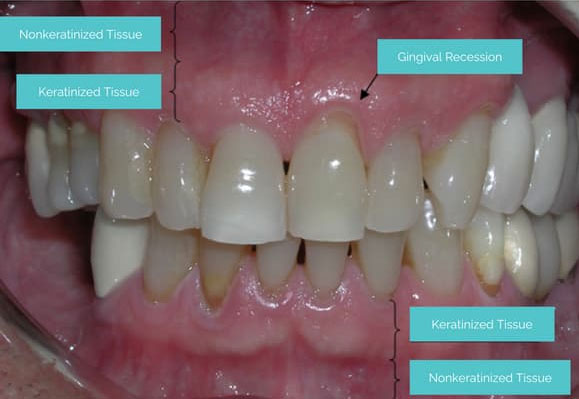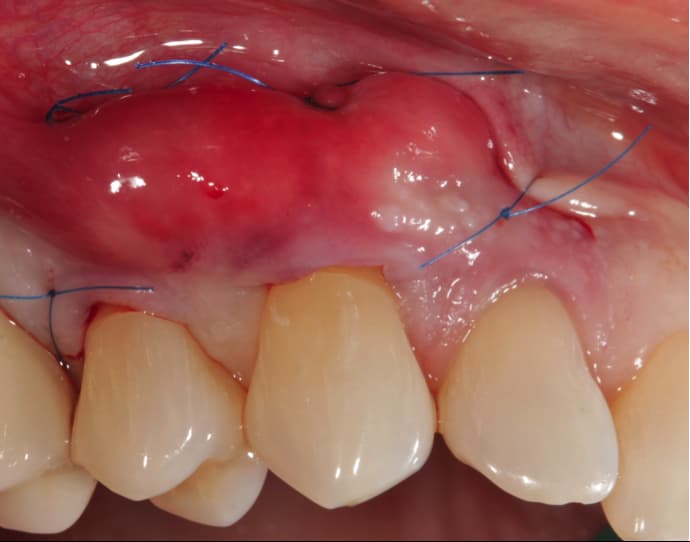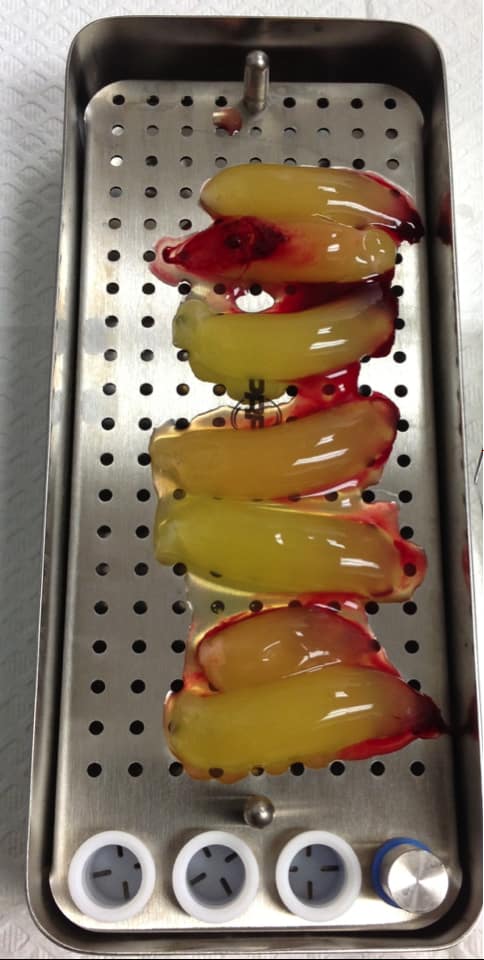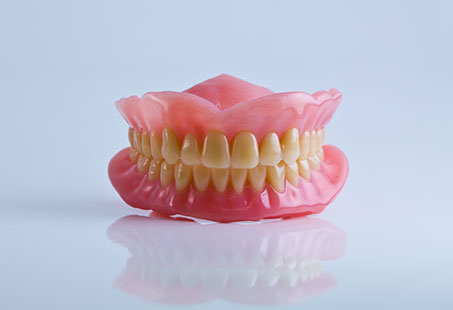The gum tissue isn’t only important for holding teeth in place; it also protects the underlying tooth roots and jawbone, keeping the bacteria out.
So, when the integrity of the gum tissue is compromised, for one reason or another, you need treatment like gum grafting.
Through this, your dentist will repair the gum tissue that has been lost. And keep in mind that if you don’t get this treatment in time, it can lead to tooth and bone loss. You need gum tissue to have good oral health.
What Is A Gum Graft?
In gum grafting, healthy tissue from inside the mouth is harvested and grafted or attached to the area where the gum has receded or thinned.
Gum recession can occur due to different reasons, such as:
- Gum disease
- Poor oral hygiene
- Smoking
- Hormonal changes
- Diabetes
- Poor nutrition
- Wearing braces
- Aggressive brushing

Also, some people end up needing a gum graft simply because they’re born with weaker and thinner gum tissue.
Tissue added to the gums through grafting will protect the exposed tooth roots and underlying jawbone from bacterial invasion.
Can Gum Tissue Grow Back?
Gum tissue cannot regenerate or grow back on its own. If your gums have receded, you shouldn’t expect them to get back to their original length, even if you have good oral hygiene. You’ll need treatment for this.
Also, if your gums are receding due to an underlying oral health problem, the gum tissue will continue to pull back from the surface of the teeth. And this will only worsen your oral health problems.
Who’s A Candidate for Gum Grafting?
You’re a good candidate for gum grafting if your gums have severely receded or thinned out. Keep in mind that this process can be gradual, so you might not notice it happening until it’s gotten quite worse.
So, it’s a good idea to keep an eye out for the following signs and symptoms of exposed tooth roots:
- Redness
- Swelling
- Tenderness
- Sensitivity
- Tooth/teeth look longer
- Bleeding
- Pain
Symptoms can vary depending on the cause of gum recession. However, if you’re experiencing any of these, it’s important that you visit a dentist.
When Is It Too Late For Gum Grafting?
The truth is that it’s never too late for gum grafting. Even if you’ve lost your tooth, you need to get gum grafting to prevent severe damage to your jawbone.
Not just that, but you also need gum grafting if you want to restore the aesthetics and function of your teeth through dental implants Turkey and artificial restorations like crowns or veneers.
In the case of dental implants, having healthy gum tissue and bone is very important to reduce the risk of implant failure.
So, it’s never too late to get gum grafting. Although the sooner you get this treatment, the better it will be because extensive dental work will cost you more (in many ways).
What Is the Procedure For Gum Grafting?
Once you arrive at the clinic, the dentist will begin by administering local anaesthesia (sedation is also an option if you have a dental phobia).
Following that, the dentist will make an incision and lift the flap of the gum tissue in the affected area to clean it. If needed, scaling and root planing may also be performed.
Once the “recipient area” has been prepared, the dentist will move on to harvesting tissue from the donor area.
Here, there are 3 different types of gum grafts that can be done:
- Connective Tissue Graft: On the roof of your mouth, an incision will be made to lift a flap of tissue. From underneath that, a small piece of connective tissue will be extracted and placed underneath the lifted flap in the recipient area. Once that’s done, this “donor site” will be stitched back up.
- Free Gingival Graft: Here, too, the donor site is the roof of the mouth. However, in this, there’s no need to lift the gum tissue because the tissue is taken from the outer top layer. This kind of gum graft is needed when the gums are severely receded.
- Pedicle (Flap) Graft: When the gum tissue next to the affected tooth is partially cut and draped over the affected area, it’s called pedicle grafting. However, this can only be done if there is ample gum tissue in the adjacent tooth. If there isn’t, and pedicle grafting is done regardless, gum recession can end up occurring in the donor area as well.
In more severe cases (when larger areas need to be covered), tissue is sourced from a tissue bank (where it can come from cadavers or pigs).
Nevertheless, once the graft is harvested and placed in the area of gum recession, it is sutured with a dressing on top. The entire procedure takes about an hour, but it can take longer if multiple teeth need grafts.
What Is The Aftercare & Recovery For Gum Grafting?
For a couple of weeks, you might have some difficulty talking and eating. Make sure to take your prescribed medication during that time.
If you have dissolvable stitches, they’ll disappear after a week. If not, your dentist will remove them after 1-2 weeks.

You can get back to work after a few days, but it’s best to avoid any strenuous activity for some time as it can increase the risk of bleeding.
Other than that, do not poke the affected areas with your tongue or touch them with your fingers. Do not pull back your lip or cheek either, as the tension from pulling can end up dislodging the graft.
You’ll also be asked not to brush or floss your teeth for a week or so (confirm this with your dentist) because it can dislodge the graft. Your dentist might ask you to use an antibacterial mouthwash to keep the area clean.
After your gum tissue has healed, if you don’t like the shape of your gums, you can have a gum contouring procedure.
What To Eat After Gum Grafting
As you’ll have stitches inside your mouth, eating and drinking can be difficult for a while. For about 2 weeks, you need to eat foods that are soft and cool, such as:
| Drinks | Sweet | Savoury |
| Milkshake | Ice-cream | Soups (not hot) |
| Smoothies | Pudding | Beans |
| Milk | Bananas | Eggs |
| Water | Yoghurt | Cottage Cheese |
| Applesauce | Tofu |
Just make sure to avoid any foods that are too hard, crunchy or spicy. Also, do not use a straw as the pressure from it can dislodge the blood clot on the surgical wound.
For your ease, your dentist might fit a palatal stent on the roof of your mouth. Furthermore, if possible, they will align the recipient and donor areas on the same side of your mouth so that you can comfortably eat on the opposite side.
What Are the Expected Side Effects of Gum Grafting?
The following side effects are expected after a gum graft surgery:
- Swelling
- Bleeding
- Discomfort
- Pain
- Bruising
It should start to get better after 2-3 days, but it depends on how extensive the procedure is. Just make sure to take your medicines and follow the instructions of your dentist.
If you’re bleeding excessively or you have pus in the surgical areas, get in touch with your dentist immediately.
How Long Do Gum Grafts Last?
Gums grafts are permanent and will last for a lifetime. However, you have to make sure that you’re taking good care of your oral health.
Make sure to brush your teeth twice a day, floss and use mouthwash. Additionally, refrain from using any tobacco products. And make sure to get regular dental checkups.
Having gum grafts doesn’t mean that your gums will never recede again. If not taken care of, they can certainly pull back again, leaving your tooth roots exposed. In that case, you’ll need to get a second gum grafting treatment.
What Are The Signs & Causes of Gum Graft Failure?
According to a study published in the Journal of The Canadian Dental Association, there’s a 2% risk of gum graft failure. So, it is something that can happen, even if quite rarely.
One of the biggest signs of gum graft failure is that the graft will start to turn white. That means that the blood supply to the graft has been cut.
An infection can also lead to gingival graft failure, in which case you’ll notice pus in the surgical areas.
There are other reasons why this can happen, which include:
- Improper surgical technique
- Not following aftercare instructions
Keep in mind if you smoke, brush too hard, or eat hard, crunchy foods while you’re in the recovery phase, a graft failure can occur.
In this case, you can get another gingival graft, but you need to wait for 3 months to allow the tissues to heal.
Are There Alternatives To Gum Grafting?
One of the alternatives to gum grafting is the Chao Pinhole technique. In this, a needle is used to make a small hole in the gum tissue.
Through the opening of this hole, special instruments are used to loosen up and lengthen the gum tissue over the exposed tooth roots.
There’s another, relatively new, treatment for receded gums. It makes use of platelet-rich fibrin, which is obtained from the patient’s blood.

Containing different growth factors, it may help the gums heal without the need for a gum graft. However, more research is needed into the effectiveness and safety of PRF.
How Much Is A Gum Graft?
Gingival grafting is available on the NHS in the Band 2 dental treatment for £65.20.
However, if you’re getting the treatment privately, gum grafting can cost you £300-600 in the UK for just one tooth. The price varies depending on the type of graft you’re getting.
In the US, a gum graft can cost you $500-1,000 for one tooth. Your insurance may also cover some of the cost of this procedure.
For more affordable treatments, you can also consider becoming a medical tourist. In Turkey, this surgery can cost you somewhere between £200-500.
Conclusion
If your gums have pulled away from your teeth, it’s important that you get them treated as soon as possible.
One of the most common treatments for gum recession and gum thinning is gingival grafting, which will take healthy tissue (from you or someone else) and place it in the affected area.
The surgery can successfully repair your gum tissue, with results lasting for a lifetime. And it’s important that you get this treatment to improve your overall oral health.
Even if you plan to get dental restorations, your dentist may require you to undergo this procedure first. In any case, it’s always a good idea to talk to a dental professional for a more accurate treatment plan.
Reviewed and approved by Dr Izbel Aksit
